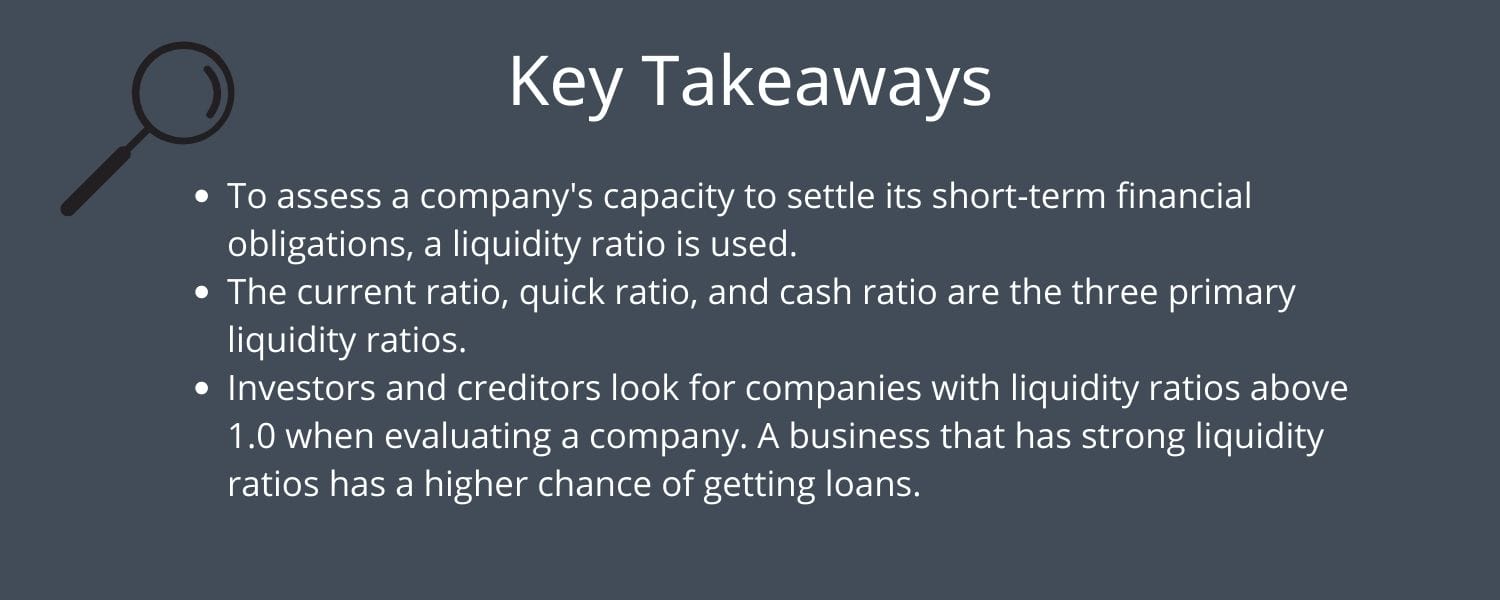In times of financial uncertainty, finding companies with a good amount of liquidity provides a margin of safety. Companies in good shape regarding liquidity can react to any crisis by taking advantage of opportunities.
Beyond safety, the two reasons above help explain why Berkshire Hathaway carries so much cash on its balance sheet. The current level hovers around $105 billion, consisting of cash, equivalents, and short-term investments.
The cash balance represents around 12 percent of the company’s total assets. The balance doesn’t include Berkshire’s investment portfolio or other current assets. But it does give Buffett a lot of ammunition in the case of buying back shares or buying another company.
Cash is king, and companies with better liquidity give themselves a better opportunity to react to good or bad news. It also helps investors find more financially fit companies.
In today’s post, we will learn:
- What Are Liquidity Ratios?
- What Are The Three Liquidity Ratios?
- Why Liquidity Ratios Are Important
- Examples Using Liquidity Ratios with Real Companies
- Investor Takeaway
Okay, let’s dive in and learn more about liquidity ratios.
What Are Liquidity Ratios
We can use a financial statistic called a liquidity ratio to assess a company’s capacity to settle its short-term loan obligations. The statistic aids in figuring out if a business can use its liquid or current assets to pay its current liabilities.

The measurement of indicators such as the current ratio, quick ratio, and operating cash flow ratio allows us to calculate liquidity ratios, which assess a company’s capacity to satisfy debt obligations. It becomes a form of a margin of safety.
The capacity to quickly and affordably turn assets into cash is known as liquidity. The best application of liquidity ratios is in comparison form. We can use both internal and external analysis.
For instance, employing numerous accounting periods reported using the same accounting standards is necessary to internal study liquidity ratios. Analysts can follow changes in the firm by comparing historical periods to current operations. A higher liquidity ratio, in general, indicates that a business is more liquid and has better coverage of its outstanding loans.
For each liquidity ratio, the equation’s numerator is the number of liquid assets, and the denominator is the number of current liabilities.
We look for ratios above 1.0 due to the ratio’s structure, which places assets on top and liabilities at the bottom. With a ratio of 1, a business may fully cover all of its current liabilities with its cash on hand. A ratio of less than 1 (for example, 0.75) would indicate that a business cannot pay its present obligations.
A ratio higher than 1 (for example, 2.0) would indicate that a business can pay its present obligations. A corporation may cover its present liabilities twice with a ratio of 2.0. If they had a ratio of 3, they could pay their existing liabilities off three times, and so on.
What Are the Three Liquidity Ratios
The three main types of liquidity ratios are:
Current Ratio
Current Ratio = Current Assets / Current Liabilities
The easiest liquidity ratio to calculate and understand is the current ratio. On a company’s balance sheet, the line items for current assets and current liabilities are simple to locate. We can calculate the current ratio by dividing current assets by current liabilities.

Quick Ratio
Quick Ratio = (Cash + Accounts Receivable + Marketable Securities) / Current Liabilities
A more stringent liquidity test than the current ratio is the quick ratio. Both are comparable because the denominator is current liabilities, and the numerator is current assets.
The quick ratio, however, only takes specific current assets into account. It considers more movable assets, including cash, receivables, and marketable securities. Because they are less liquid than current assets, such as inventory, which the ratio excludes. Therefore, the quick ratio is a better gauge of a company’s capacity to meet its immediate obligations.
Cash Ratio
Cash Ratio = (Cash + Marketable Securities) / Current Liabilities
The cash ratio extends the liquidity test. This ratio only considers a company’s cash and marketable securities, the most liquid assets. They are the assets that a business can use to meet short-term obligations the quickest.
We can consider the current, quick, and cash ratios as easy, medium, and hard liquidity assessments, respectively.
Something to keep in mind when considering using liquidity ratios.
An appropriate ratio will vary between the three ratios because they depend on the numerator employed in the equation. It makes sense because the current ratio considers all current assets, whereas the cash ratio considers cash and marketable securities in the numerator.
Consequently, a good current ratio will be greater than a good quick ratio. Both will exceed the permitted cash ratio. An organization might, for instance, have a current ratio of 3.1, a quick ratio of 1.1, and a cash ratio of 0.94. Analysts and investors may view all three as strong, depending on the company.
Why Liquidity Ratios Are Important
A firm’s liquidity measures how easily it can access the cash it needs to meet its short-term obligations, including paying its invoices.

Companies must have enough liquid assets, such as cash on hand or securities that they can quickly convert, to meet their obligations while still making payroll, paying suppliers, and running their business.
Companies with strong liquidity remain well-positioned in terms of cash and current assets and can pay short-term obligations. Companies with limited liquidity may struggle to do so without outside funding, which may be more difficult to obtain if they are actually in financial distress.
We can use liquidity ratios to determine if a company’s liquidity is improving or worsening over time when tracking across various accounting periods.
Liquidity ratios help analysts and investors determine whether companies may be in a superior liquidity position when measured across businesses in the same industry.
Comparing liquidity ratios is less useful when examining the financial health of businesses in various industries or when we examine a broad range in sizes of businesses because those businesses may need different financing arrangements.
We can obtain a more realistic picture of a company’s financial health by employing liquidity ratios, other measures, and industry trends.
Companies may overcome a liquidity issue by pledging part of their assets to raise cash, barring a system-wide credit crunch.
Investors use liquidity ratios to evaluate businesses and determine whether they are financially sound and deserving of their money. The rest of the firm could also feel constrained by working capital problems. A business must be able to pay its short-term obligations with considerable room for error.
Low liquidity ratios are concerning, although the adage “the higher, the better” is only partially true.
Investors may, at some point, wonder why a company’s liquidity ratios are so high. A business with a liquidity ratio of 8.5 will undoubtedly be able to meet its short-term obligations, but investors could find that excessive. An unusually high ratio indicates the company has a lot of liquid assets.
Investors and analysts might think a company’s cash ratio of 8.5 was too high. The company has an excessive amount of cash on hand, only generating the interest the bank gives to store the company’s cash.
We could argue that the business should use the funds for other projects and investments with a higher chance of better returns.
With the use of liquidity ratios, it is possible to strike a compromise between a company’s ability to pay its debts on time and inefficient capital allocation. Companies should optimize the use of capital to maximize the firm’s value for shareholders.
Examples Using Liquidity Ratios with Real Companies
Let’s utilize a few of these liquidity measurements to illustrate how well we can use them to evaluate a company’s financial health.

Google and Microsoft, two competitors in the cloud computing space, have the following assets and liabilities on their balance sheets (figures in millions of dollars). We can use our liquidity ratios to analyze the financial condition of both companies.
Balance Sheets for Google and Microsoft
| In millions of $ | | Microsoft |
|
Cash & Equivalents |
$17,936 |
$13,931 |
| Marketable Securities |
$118,074 |
$90,818 |
|
Accounts Receivable |
$39,304 |
$44,261 |
|
Inventories |
$1,170 |
$3,742 |
|
Current Assets |
$188,143 |
$169,684 |
|
PP&E |
$110,558 |
$87,546 |
|
Intangible Assets |
$24,373 |
$78,822 |
|
Total Assets |
$359,268 |
$364,840 |
|
Current Liabilities |
$61,952 |
$89,045 |
|
Long-Term Debt |
$12,844 |
$47,032 |
|
Total Liabilities |
$107,633 |
$198,298 |
|
Shareholders’ Equity |
$251,635 |
$166,542 |
For our example, we will assume current liabilities consist of accounts liable and other current liabilities, with no short-term debt used in the calculations.
- Current Ratio = $188,143 / $61,952 = 3.04
- Quick ratio = ($17,936+$118,074+$39,304) / $61,952 = 2.82
- Cash Ratio = ($17,936 + $118,074) / $61,952 = 2.20
- Debt to Equity = $12,844 / $251,635 = 0.05
- Debt to Assets = $12,844 / $359,268 = 0.04
Microsoft
- Current Ratio = $169,684 / $95,082 = 1.78
- Quick Ratio = ($13,931 + $90,818 + $44,261) / $95,082 = 1.56
- Cash Ratio = ($13,931 + $90,818 ) / $95,082 = 1.10
- Debt to Equity = $47,032 / $166,542 = 0.28
- Debt to Assets = $47,032 / $364,840 = 0.13
From these ratios, we can infer several things about the financial health of these two businesses.
There is a lot of liquidity at Google. According to its current ratio, it has $3.04 in current assets for every dollar in current liabilities. With $2.82 in assets that can quickly convert to cash for every dollar of current liabilities, it has a quick ratio that indicates good liquidity even after eliminating inventories.
We can also see that Microsoft operates with a lot of liquidity as well. The company generates $1.78 in current assets for every dollar in current liabilities. And $1.56 in assets, Microsoft could turn to cash for every dollar of liabilities. Both ratios indicate good liquidity for Microsoft.
Another good idea is to look at longer trends of the ratios to give us additional insights into operational liquidity. For example, Google generated the following current ratios over the last five years:
- 2017 = 5.14
- 2018 = 3.92
- 2019 = 3.37
- 2020 = 3.07
- 2021 = 2.93
For further analysis, we should look at other competitors to see how Google stacks up in their sector for the latest period.
| Company | Current Ratio | Quick Ratio | Cash Ratio |
|
Salesforce |
1.06 |
1.06 |
0.67 |
|
Adobe |
1.14 |
1.14 |
0.77 |
|
Oracle |
0.6 |
0.6 |
0.32 |
|
Accenture |
1.27 |
1.27 |
0.41 |
|
Snowflake |
3.21 |
3.21 |
2.82 |
|
Atlassian |
1.19 |
1.19 |
0.91 |
What can we take away from the above chart?
At first glance, only Snowflake rates liquidity-wise with Google and Microsoft.
Snowflake generates high liquidity compared to others in the chart, which is unsurprising as the company continues to generate tremendous revenue growth. Snowflake also IPO’d not long ago, which gives them a large amount of cash on the balance sheet, helping boost the company’s liquidity.
We can also see that Oracle carries the lowest liquidity ratios of the group.
Remember that all these companies are at different points in their lifecycles, and the “older” companies like Oracle might struggle to generate free cash flow as revenue slows. Where a company like Snowflake or Atlassian, the “youngsters” of the group generate great revenue growth, allowing them to create greater liquidity.
Another consideration we need to consider is the company’s solvency.
We refer to a short-term obligation’s ability to be met as liquidity. On the other hand, a company’s ability to fulfill long-term obligations refers to its solvency. For a business, this frequently entails being able to pay back principal and interest on loans (like bonds) or long-term leases.
Although a company’s solvency is longer-term, its liquidity ratios may indicate future solvency concerns. A corporation must normally have more current assets than current liabilities to be deemed liquid.
Although a company’s solvency does not always correlate with its liquidity, liquidity ratios can highlight future solvency concerns.
Investor Takeaway
The term “liquidity” describes how quickly or easily a company can raise money to cover short-term obligations like bills. Liquid assets include those that can be easily sold, such as stocks and bonds (although cash is the most liquid asset of all).
Businesses need to have enough cash to satisfy their expenses and obligations to pay their suppliers, make payroll, and maintain day-to-day operations.
Fundamentally, all liquidity ratios computed by dividing current assets by current liabilities assess a company’s capacity to pay short-term obligations (CL). The quick ratio also includes marketable securities, accounts receivable, and cash equivalents (such as money market holdings). In contrast, the cash ratio considers the amount of cash on hand divided by CL. The current ratio includes all current assets.
What happens if liquidity ratios show a company isn’t liquid?
If circumstances make it impossible to meet short-term obligations, such as repaying loans and paying employees or suppliers, a liquidity crisis may develop even in healthy organizations.
The worldwide credit crunch of 2007–2009 is one recent example of a severe liquidity crisis, during which many businesses could not obtain short-term financing to meet their urgent obligations. Those companies went bankrupt, and shareholders got wiped out.
And with that, we will wrap up our discussion regarding liquidity ratios.
Thank you for reading today’s post; I hope you find something of value. If I can be of any further assistance, please don’t hesitate to reach out.
Until next time, take care and be safe out there,
Dave
Related posts:
- Balance Sheet Analysis: 5 Important Ratios for Measuring Company Health A good deal about the health of a company can be learned from conducting balance sheet analysis and this article will go in depth on...
- What’s the Ideal Quick Ratio? The 3 Simple Questions to Consider The quick ratio is a worst-case scenario metric. It helps you project if a company could survive if revenues were to dry up. The quick...
- How the Working Capital Turnover Ratio Can Help You Decide on a Worthy Investment “Over the long term, it’s hard for a stock to earn a much better return than the business which underlies it earns. If the business...
- What’s a Good Debt to Equity Ratio? The Ultimate Guide for Beginners The debt to equity ratio is a great formula for investors to use as a rule of thumb for determining the riskiness of a stock,...
